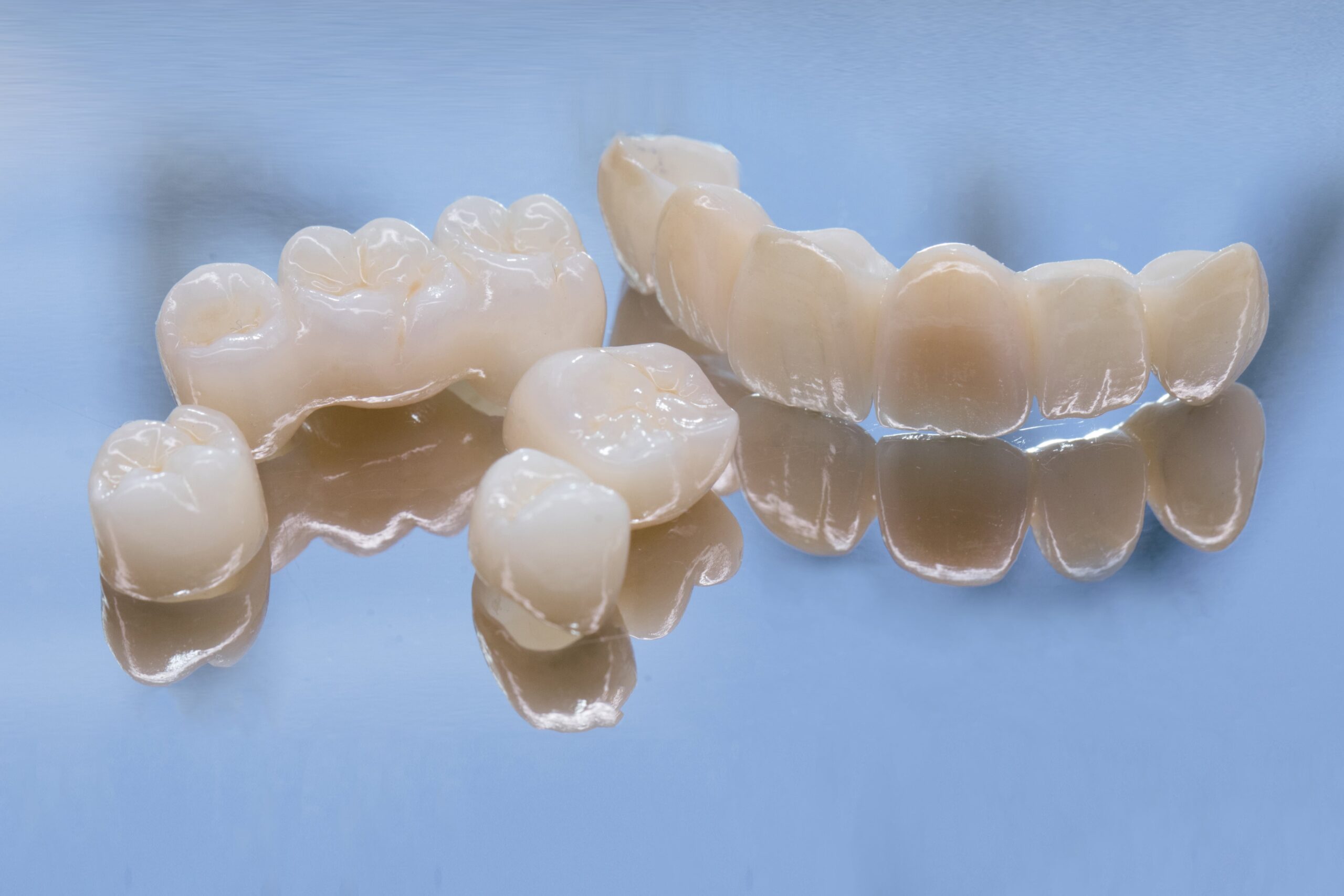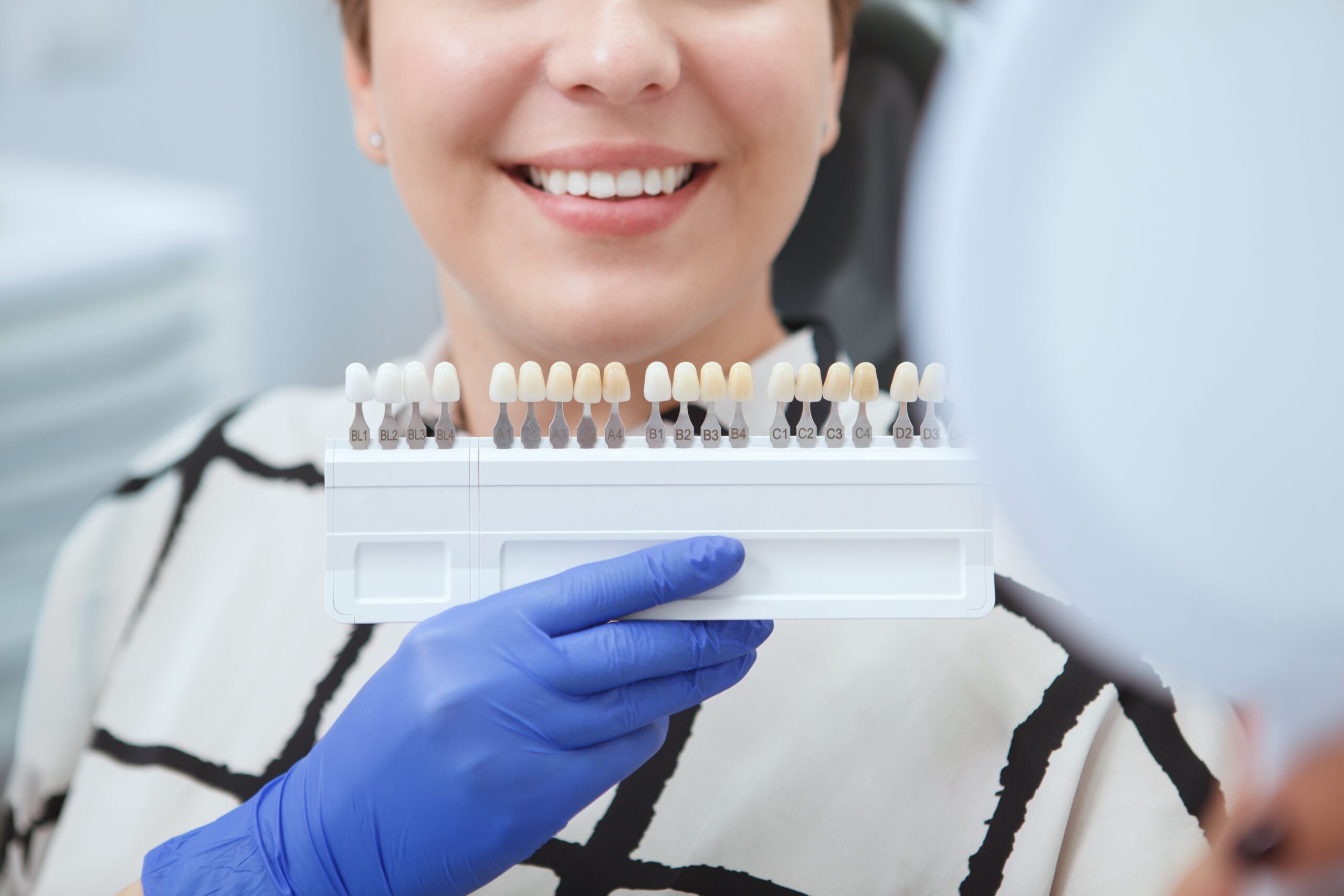High quality dentures – fixed and removable – for function, comfort and a natural smile.
Teeth are important for chewing function, speech and natural appearance. Well-functioning and beautiful teeth influence well-being. In the field of dental prosthetics, we deal with the restoration of dentition in the event of the loss of one, several or all teeth. Dental diseases such as periodontitis and tooth decay, accidents or teeth grinding can be reasons why you choose dentures. Because missing teeth limit the quality of life and reduce self-esteem.
Our goal is to best preserve the remaining tooth structure and bone in accordance with the individual needs of the patient in order to restore the function and appearance of the teeth. In detailed consultations, we will work with you to develop your individual treatment goals using numerous examples and explain the different treatment options and prosthetic materials to you.
A dental bridge is a tooth replacement that is used to close gaps in the teeth. In contrast to removable dentures, a dental bridge is firmly fixed in the mouth. It is typically placed between two crowned teeth that serve as a support. These crowned teeth provide a stable base for the bridge. It can be a great solution to improve the appearance of your smile as it closes the visible gaps while restoring normal chewing function.
Think of a dental crown as a type of protective shell made specifically to cover a damaged tooth. If a tooth has been severely damaged by tooth decay or after an accident, a crown can be inserted. The crown is placed over the tooth, restoring the tooth’s natural appearance and full function. In some cases, crowns also serve as part of a bridge to replace missing teeth and thus close larger gaps.
Dental bridges are known for their longevity. With good care, they can last between 10 and 20 years, which is a significant amount of time compared to other denture options.
Unlike removable dentures, dental bridges sit firmly in the mouth. This means they offer a more stable solution and enable a more natural feeling when speaking and eating.
The placement of a dental bridge usually does not require any surgical procedures. This makes the procedure less invasive than, for example, inserting implants.
Dental bridges not only restore the external appearance, but also the functional integrity of the dental system. This significantly improves the patient’s ability to chew and speak.
Tooth preservation: If a tooth is severely damaged, a crown can effectively save it. The crown surrounds the tooth and protects it from further damage or tooth decay.
Functional restoration: A dental crown may not replace the entire tooth, but it stabilizes the remaining portion so it stays in place and can continue to withstand heavy loads. This means that the natural chewing function of the tooth is restored, which is essential for a pleasant eating experience.
Longevity and robustness: Dental crowns show remarkable stability, especially in the area of the molars, where the load is high. With proper care they can last a very long time; Many metal-ceramic crowns are still in excellent condition even after more than 20 years.
Aesthetic result: Ceramic crowns in the area of the front and canine teeth in particular offer excellent aesthetic quality. They adapt to the color of the natural tooth and can hardly be distinguished from it. This makes them ideal for the visible area of the teeth, where natural aesthetics are particularly important.
In order for a dental bridge to be used, the following requirements must be met. First and foremost, an inflammation-free mouth, which means that your gums, teeth and jawbone are thoroughly examined and treated if necessary. The stability of the bridge depends heavily on your abutment teeth. If these teeth are not suitable due to disease, misalignment or weakness, consider alternative options such as implant-supported crowns or removable dentures. It is also advisable to replace any amalgam fillings in the abutment teeth with non-metallic alternatives to create optimal conditions for the bridge. Dental bridges are usually firmly anchored and should ideally only replace one or two missing teeth to ensure sufficient stability when chewing.
In order to successfully crown a tooth, certain requirements must be met to ensure a long-term solution. First, the gums around the affected tooth should be healthy. Secondly, the tooth root should not show any signs of inflammation as this could affect the stability of the crown. Thirdly, the tooth root must be firmly anchored in the jawbone to ensure that the crown is stable and supports normal tooth function. If these conditions are met, the tooth is usually a suitable candidate for a crown.
If you decide to get a dental bridge, the process takes place in several steps:
First, in one of our Lifedent practices in Lucerne, Volketswil, Bülach, Winterthur or Neukirch, we prepare your neighboring teeth, which will serve as supports for the bridge. These are carefully ground to size, similar to a crown. If necessary, caries is removed and the teeth are strengthened. Care is taken to ensure that the abutment teeth are straight and stable. Impressions are taken and the tooth color is determined to make the bridge appear natural. You will receive a temporary denture until your next appointment.
Next time you visit, try the bridge for the first time. We check whether they fits exactly and is comfortable. The bridge is made with an aesthetic ceramic layer covered to complete it. For larger bridges, another one can be used Fitting may be necessary to ensure a perfect fit.
The finished bridge is inserted and firmly glued. The bridges must not cause any tension and should fit harmoniously into your teeth.
If you are considering whether a dental crown is the right option for you, I would like to give you an overview of the typical treatment process.
First consultation
Everything begins with a thorough consultation in one of our Lifedent practices in Lucerne, Volketswil, Bülach, Winterthur or Neukirch. Your mouth will be comprehensively examined and, if necessary, an X-ray will be taken to assess the condition of the affected tooth more precisely. Your dentist will check whether the tooth nerve is healthy and whether there is enough tooth structure to support the crown.
Tooth preparation
The next step is to prepare your tooth for the dental crown. Damaged tooth material is removed and the tooth is ground accordingly. An impression of your prepared tooth will be taken to create your custom crown. While the final crown is being made, you will receive a temporary mouth guard.
Adjustment and attachment
The temporary restoration is removed, the tooth is cleaned and the new crown is fitted. Your dentist will carefully check the fit and bite, make any necessary adjustments and finally fix the crown with a special adhesive.
Aftercare
Finally, a follow-up appointment will be arranged to check how you feel with the new crown and whether everything is going optimally.

A dental bridge consists of two important parts: the bridge body and the bridge members. The number of bridge units depends on how many teeth are missing and need to be bridged. These bridge members can be made from different materials. Some are made of precious metals that are then covered with ceramic, while others are made entirely of ceramic. So there are different options depending on individual needs and preferences.
There are different materials that dental crowns can be made from. Metal crowns and veneer crowns are two common options. Metal crowns consist of a metal framework covered with a thin layer of ceramic. These are usually attached to the damaged tooth using a special medical cement. Veneer crowns are similar, but they have a more aesthetic ceramic outer layer. Pure ceramic crowns are often attached with a special plastic adhesive to ensure a secure fixation. The choice of material depends on individual needs and aesthetic preferences.

This bridge sits on the jaw ridge and is a classic choice for closing gaps between teeth.
Unlike the basic bridge, the pontic of this bridge does not directly touch the jaw. It is ideal for the back of the mouth where it is not visible.
If there is no other tooth on one side of the gap, this bridge is used. It is perfect for smaller gaps.
This bridge combines different materials or attachment methods, such as the combination of a natural tooth and an implant as an abutment.
This bridge is gently attached by being glued to the neighboring teeth. Particularly suitable for younger people.
Here, inlays are used to attach the bridge to the adjacent teeth, instead of crowns.
This bridge can be removed and cleaned yourself, similar to removable dentures, but offers additional comfort.
With telescopic crowns consisting of inner and outer layers, this bridge is well suited for removable dentures.
This bridge is attached to the inside of the adjacent teeth using a special adhesive technique.
To attach a bridge, it is often necessary to grind the adjacent teeth, a process also known as “slicing.” This creates healthy tooth structure
Grinding down tooth enamel can make teeth more vulnerable, often leading to increased sensitivity. Those affected may then suffer from pain or an unpleasant feeling when they come into contact with hot or cold foods.
The edges of crowns and bridges can be particularly susceptible to tooth decay. Without careful oral hygiene, bacteria can accumulate in these areas, which then leads to tooth decay and shortens the lifespan of the bridge.
If a bridge is not precisely aligned, this can result in chewing forces being distributed unevenly across the adjacent teeth. This can cause overuse of these teeth and cause long-term damage.
For ceramic crowns, it is sometimes necessary to remove a little more of the natural tooth structure to ensure the required material thickness and optimal strength.
Accurate crown adjustment is critical to ensure long-term comfort and functionality. However, if the crown does not fit perfectly, this could lead to inflammation or an increased susceptibility to tooth decay.
Dental crowns are an investment in your dental health that may involve initial costs but offer the advantage of a permanent and aesthetic solution.
Although dental crowns are strong and durable, their lifespan is not unlimited. Regular checks and, if necessary, replacement of the crown help to maintain the health of the underlying tooth.
In Switzerland, the cost of crowns and dental bridges can vary depending on various factors such as the type of material, the complexity of the procedure, etc. In general, crowns can cost between 800 and 2000 CHF.
Prices for dental bridges can range between 1,500 and 4,000 CHF. However, it is important to note that these are only rough numbers and the actual costs are individual. It is advisable to seek advice directly from one of our Lifedent practices in Lucerne, Volketswil, Bülach, Winterthur or Neukirch to get an accurate estimate of the costs for your specific situation.
The lifespan of crowns and bridges is an important factor that many consider when choosing their dentures. Good care can help them last longer.
Crowns, especially those made from solid cast, can typically last between 15 and 25 years. The quality of the materials, the accuracy of the fit and your daily dental care influence the durability.
Dental bridges can also last around 15 years if properly installed and cared for. Your personal oral hygiene plays an important role.
Regular visits to one of our Lifedent dental practices in Lucerne, Volketswil, Bülach, Winterthur or Neukirch are crucial in order to optimally care for your dentures and identify problems at an early stage.